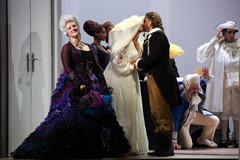| Opera Reviews | 6 May 2024 |
La Scala's new Figaro fails to igniteby Silvia Luraghi |
|
| Mozart: Le nozze di Figaro Teatro alla Scala, Milan 8 November 2016 |
|
|
Replacing the classic Giorgio Strehler production, which, after its premiere in 1981, was successfully revived until 2012, was certainly not an easy task. Stage director Frederic Wake-Walker in collaboration with set and costume designer Antony McDonald tried his best, but failed to convince the numerous members of the public that crowded the sold out house, showing that the title remains an audience favorite in Milan and accordingly deserved a more careful staging. Criticisms concerned the crowd of dancers and other extras going up and down on stage at frequent times during the action with no clear purpose, accompanied by the parody attitude of the main characters, rather than an in-depth psychological characterization. Indeed, Mozart and Da Ponte never saw the characters in this light, and Figaro is not an inherently comical piece of work. Rather, the characters are real people, with contradictory feelings that an expert stage director should highlight by following the libretto and the score. The rotating sets at the center of the stage reproduced various settings in the Count’s palace, while black dressed women (changing to white in the second part of the opera) assembled and disassembled parts of the sets. Principals were also very active, with Figaro jumping here and there, and the count moving in a hectic way. In order to stress the supposedly fictitious character of the piece, the stage director had a prompter, an old-looking guy in a wig, sit on the side of the stage and at times reminding the singers of a word in a recitativo, a rather confusing idea. In contrast with the exceedingly lively stage playing, Maestro Franz Welser-Möst in the pit provided a solid lead to the orchestra, but remained somewhat on the monotonous side. Better notes came from the stage, with a stellar cast featuring a number of Mozart specialists. Diana Damrau was an outstanding Countess, with her sharp, perfectly tuned and nicely colored soprano, sad but yet touchingly tender inasmuch as the stage director allowed her to be. Golda Schultz was a very good Susanna, with a lightly colored, easily reached top range and a slightly temperamental, yet playful character. The performance I saw featured Simon Keenlyside in the role of the Count after some performances with Carlos Álvarez. In principle, Keenlyside is perfect for this role, but his rendering of the character was heavily conditioned by the director’s reading of the text, and was not entirely compelling. Likewise, Markus Werba is certainly among today’s best possible Figaros, but his interpretation in this production will not remain memorable. Marianne Crebassa was a vocally interesting Cherubino, confused and clumsy as a teenager usually is. The company put a great effort in promoting this production, offering free tickets for the dress rehearsal and a live telecast of the fourth performance on public TV. One wonders whether a further revival of the Strehler production wouldn’t have been a better way to attract a new audience to the opera.
|
|
| Text ©
Silvia Luraghi Photo © Teatro alla Scala |

 A new production of Mozart’s Le nozze di Figaro is currently being shown at La Scala as a celebration of the 225th anniversary of the composer’s death.
A new production of Mozart’s Le nozze di Figaro is currently being shown at La Scala as a celebration of the 225th anniversary of the composer’s death. 





